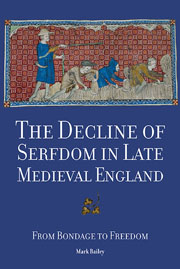Book contents
- Frontmatter
- Contents
- List of Maps
- List of Graphs
- List of Tables
- Acknowledgements
- Abbreviations
- Part I The Decline of Serfdom: Questions and Approaches
- 1 The Decline of Serfdom and its Historical Significance
- 2 The Chronology of Decline: Villein Tenures
- 3 The Chronology of Decline: Servile Incidents
- 4 The Causes of Decline
- Part II Case Studies
- Part III Conclusions
- Appendix: List of original sources used in this study
- Chronology
- Bibliography
- Index
1 - The Decline of Serfdom and its Historical Significance
from Part I - The Decline of Serfdom: Questions and Approaches
Published online by Cambridge University Press: 05 March 2014
- Frontmatter
- Contents
- List of Maps
- List of Graphs
- List of Tables
- Acknowledgements
- Abbreviations
- Part I The Decline of Serfdom: Questions and Approaches
- 1 The Decline of Serfdom and its Historical Significance
- 2 The Chronology of Decline: Villein Tenures
- 3 The Chronology of Decline: Servile Incidents
- 4 The Causes of Decline
- Part II Case Studies
- Part III Conclusions
- Appendix: List of original sources used in this study
- Chronology
- Bibliography
- Index
Summary
The vast majority of people in medieval England were rural dwellers who eked a living as peasant smallholders, landless labourers and petty traders. In c.1300 around one half of these people were ‘servile’, ‘villeins’, or ‘unfree’. These terms were used to describe peasants who were ‘bonded in some fashion to a lord or a particular piece of land. This tie was hereditary rather than merely contractual or temporary, and it placed the serf under the jurisdiction (and sometimes the arbitrary power) of the lords.’ This general condition, known as serfdom, was found throughout medieval Europe. Serfdom constrained the freedom of time and action of individuals by imposing legal restrictions upon their movement, and by placing inescapable economic burdens and rents of various sorts. These restrictions and burdens were widely regarded as degrading, and, according to leading historians such as Hilton, they enabled lords to extract from peasant families all the labour and landed produce which was surplus to their subsistence and to their basic operating needs. Serfdom is therefore regarded as an inherently exploitative relationship, skewed heavily to the benefit of landlords.
Serfdom was not present in every part of medieval Europe and, where it existed, its specific characteristics varied so much that ‘serfdom’ in one place could be very different from that in another. ‘It is such an elastic concept as to lead some historians to doubt whether the term has any analytical value … its precise form must be established empirically for each particular time and place.’
- Type
- Chapter
- Information
- The Decline of Serfdom in Late Medieval EnglandFrom Bondage to Freedom, pp. 3 - 15Publisher: Boydell & BrewerPrint publication year: 2014



